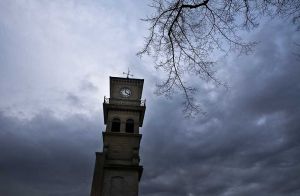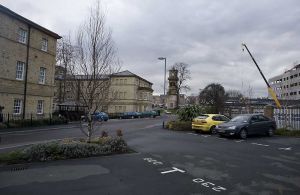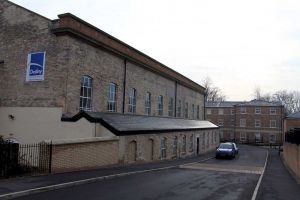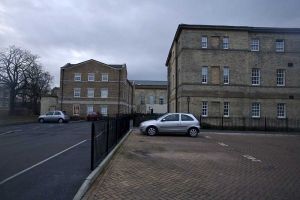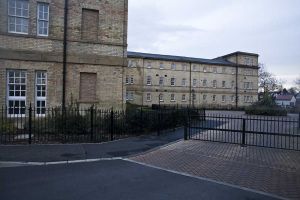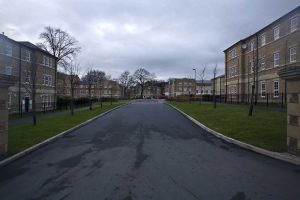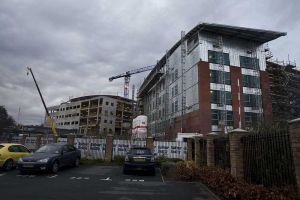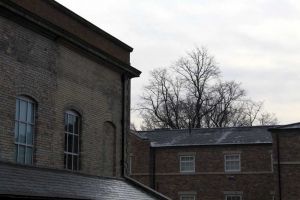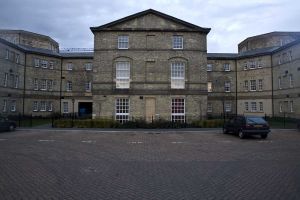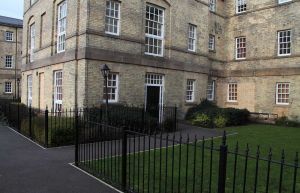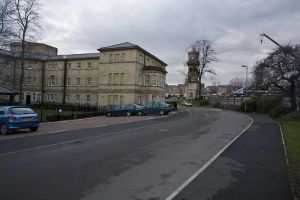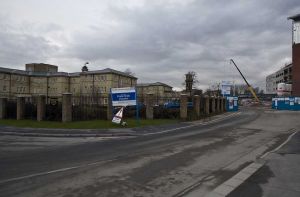The history and plan forms of Stanley Royd.
Pauper lunatic asylum, now mental hospital. 1818, with wings added 1828 and 1833, by Watson and Pritchett of York for the West Riding County Council; later C19 and C20 alterations and additions. White brick in flemish bond with stone dressings and Welsh slate roof. Laid out on an “H”-plan with short wings projecting from the cross-piece which were later extended. Each of the wings terminates in a pavilion and at the two crossing points are octagon-towers from which the wards and exercise yards could be observed. 3 storeys with 4-storey octagons and pavilions to ends of added wings. Cross-piece of 1:3:3:3:1 bays with centre break and end bays canted (forming one side of the octagons); wings project at right angles, each of 1:5:1 bays, the end bays projecting slightly; at either end of the cross-piece, beyond the octagons, were former 1-bay wings, these each extended by 10 bays.
Stone plinth, 1st floor band, 1st and 2nd floor sill bands and eaves cornice windows, now with late C20 centre-pivoting casements, have flat brick arches and stone sills; tripled windows to end bays of wings and to canted bays. Entrance front central 3-bay break, formerly under pediment, has giant angle pilasters rising to cornice with later attic storey above; bridged windows to bays 3 and 9 and to alternate sides of octagon bowers which have string below parapet; roof, hipped over end bays, has various skylights, stacks and ridge louvres; central cupola has octagonal base, tall Roman Doric columns and entablature below second stage which has squat, square columns, dome and large weather vane. C20 alterations include doors, throughway inserted in bay 9, ground floor windows of canted bays and bay-window addition to gable of right-hand projecting ring; additions to right return of this wing not of special interest.
Rear elevation: 3 central bays break forward under corniced pediment and have central 6-panel door under fanlight with glazing bars, flanked by full-height openings and similar openings above in segmental-arched recesses, the central 1st and 2nd floor windows blind. Blocked oculus to tympanium. C19 and C20 additions to ends and returns of wings are not of special interest. The extended wings on either side, are in the same style, that on the east with partial basement and large added ridge louvre, that on the west further extended and altered, the further extensions not of special interest
This asylum was only the sixth to be built in England, and was part of the contemporary development of belief that lunatics should be treated humanely and attempts made to cure them. Although built plainly and utilitarianly, the asylum represented the most advanced thought on the design of such buildings, and it provides an important link between the first attempts at classification in an asylum’s plans.
Another important feature was the octagon towers, within which rose spiral stairs, which gave onto fenestrated embrasures over looking wards, corridors and exercise yards so that patients and staff could be kept under close, but discreet, observation. The plan was advanced in providing many single rooms for the patients. The utilitarianism is shown in the use of the cupola for housing a cylinder from which exhaust air from the building escaped.
Ventilating tower. 1818. Part of Paupers’ Lunatic Asylum by Watson and Pritchett of York for the West Riding County Council. White brick in irregular bond with projecting stone bands and cap-stone. One blocked, wood-lintelled opening, and another with metal grille. Cold air was drawn through this tower into the asylum.
A L Ashworth Stanley Royd Hospital, Wakefield. One hundred and fifty years A History (1975)
E Harwood, The history and plan forms of purpose built lunatic asylums, with a study of their conservation and reuse, M.A.Thesis, for the Association.
……………………………………………………………………………………
Hospital dining hall, later recreation hall and theatre. 1859, extended to provide full working stage in 1893, probably to the designs of Bernard Hartley, the County Surveyor. Grey brick with slate roof. Nine-bay hall with one (blind) bay addition for stage, on to whose end gable the datestone of 1859 has been reinserted. To the side were formerly areas for the supervising and kitchen staffs, now small meeting rooms and not of special interest. Rebuilt parapet, windows with central opening casements.
The hall is in an Italianate style, the windows set over a high dado in aediculed surrounds with cornice brackets, alternate one’s under pediments. Panels and doors at a lower level, flat ceiling whose beams continue as pilaters between the windows, separated by deep cornice. Similar plasters either side of the moulded plaster proscenium arch over stage. Mahogany doors up narrow flights of stairs with balusters form a symmetrical composition to either side. Stage with trap, dressing rooms under.
The chief interest of this building is the survival within of a complete Victorian stage, with timber grid, fly floors and hemps. Most unusual is the grooved system for sliding stage flats in the wings: this was the standard way of hanging wings for some 200 years until this century but is now only the second surviving example discovered in England. The upper grooves are of particular importance, it is not clear whether there would always have been lower grooves and the present set is modern. The particular feature of this example is that of the four pairs of grooves two are canted to give a greater sense of receding perspective for the audience, a device not founded at the Normansfield Hospital, LB Richmond (q.v), which has the only comparable surviving working stage.
STANLEY ROYD HOSPITAL 11th March 1996
Aberford Road, Stanley, Wakefield, West Yorkshire
Stanley Royd Hospital
1. The hospital church of St Faith to remain on the list at grade II.
2. The original lunatic asylum building to remain on the list at grade II.
3. The former ventilating tower to remain on the list at grade II.
4. The hospital theatre to be added to the list at grade II.
Reasons for Listing
1. Church of St Faith.
This good example of a Gothic Revival style church was probably designed by the nationally important architect Sir George Gilbert Scott in 1861. The building satisfies the listing criteria. The present description is adequate and a detailed map showing the exact extent of all the listings on this site is enclosed.
2. Stanley Royd Hospital.
Eastern part of main range comprising early 19th century former paupers’ lunatic asylum. This extremely early and nationally important former lunatic asylum was one of the earliest institutions to attempt to treat patients humanely and also to cure them. The plan of this building was very advanced and very influential in the years that followed. This building definitely satisfies the listing criteria on both architectural and historic evidence. The present list description is adequate.
3. Former ventilating tower.
Approx 3 metres to south-west of south-west wing of former paupers’ lunatic asylum, Stanley Royd Hospital. This structure formed an important and integral part of the original asylum built in 1818, and it functioned as part of a new ventiaUing system that was used here for the the first time. The structure satisfies the listing criteria for group value only. The
present list description is adequate.
4. Theatre at Stanley Royd Hospital.
This dining hall and threatre was added to this site in 1859. It was an early example of a centralized dining hall, and is important for that reason, but it is its conversion to a theatre in 1893 which makes a significant and listable structure. It has miraculously preserved its simple Victorian theatre technology, and it is the only example that survives in working order, apart from Normansfield Hospital, already listed at grade II*. It definitely deserves to be included on the list. A list description is included.
………………………………………………………………………………………..
Images In This Collection Showing The Quaility Of The conversion, All Taken January 2009..
………………………………………………………………………………………..
Local Architects Transform Abandoned Hospital
4 May 2006
Spawforth Associates, an independent, creative consultancy specialising in Town Planning, Urbanism and Architecture, have recently received an award for the innovative transformation of a former Wakefield Hospital
Spawforths were awarded a commendation by Wakefield Civic Society in the category of Best Refurbishment (building or environmental) for their work in helping to transform Stanley Royd Hospital into the new Parklands community. Spawforths were commended for their innovative design concept that has been completed by Taylor Woodrow.
The former hospital, opposite Wakefield City Centre, had been left as an abandoned building sitting in neglected grounds. But thanks to their team of town planners, urbanists and architects Spawforth were able to redesign the Grade II Listed Buildings for conversion into 100 residential units with an additional 99 apartments in 5 blocks, along with a further 75 town houses.
For more information on Spawforth Associates please PHONE: Sarah Walters on 01924 873 873 or EMAIL: sarah.walters@spawforth.co.uk
…………………………………………………………………………………….
Victorian hospital conversion April 2005
A scheme including the conversion of former hospital to 100 apartments, former theatre to fitness centre, former church to offices, erection of 99 apartments and 75 town houses and car parking has been granted planning permission. Demolition has been completed and new building and conversion is in progress. Revised and improved road access arrangements into the site have been completed. Many units are now occupied.
